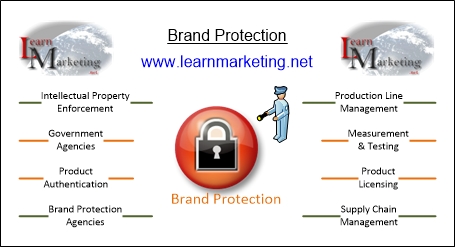Brand Protection
Part 2
Brand Protection Through Production Line Management
Firms will tightly monitor their production lines to prevent more products than are authorised, being produced (production over run). Production over runs waste resources and could lead to products being sold on the “grey market” without the firm's permission. If a 3rd party is responsible for producing products (or providing services) on a firm's behalf, the firm will tightly control the process by stipulating the method of production (or provision). Firms often carry out compliance audits and spot checks to ensure that the third party producer is producing products as agreed in the contract between them and that standards are being maintained. The audits may also analyse whether third party producers are complying with legislation, standards or regulations and whether the third party's conduct may contradict the firm's social responsibility ethos. In other words the underlying objective of third party audits is to maintain the reputation of the firm and eradicate anything which could threaten the brand.
Brand Protection Through Specialist Firms
Businesses may appoint specialist firms experienced in brand protection to advise them on how to protect their brands from counterfeiting. They will be aware of the latest brand protection techniques and can identify brand protection weaknesses in the firm's processes, supply chain or even the countries you sell your product in. Brand Protection firms offer a range of services including compliance audits, product tagging for buyers, sellers and distributors to verify the product with, invisible tags ( less likely to be copied by counterfeiters as they aren't visible to the naked eye)
Brand Protection Through Working With Government Agencies
As counterfeit products not only damage the economy but can also affect people's health and safety, there are often government agencies tasked with identifying and preventing counterfeiting activity. For example in the United Kingdom local trading standards will investigate and prosecute firms where their activities may be pose a risk to public safety or involve fraudulent practice. All countries will have border and customs officials tasked with stopping counterfeit and illegal products entering the country. Finally firms can bring civil cases against any party who they feel has infringed their intellectual property rights.
Brand Protection Conclusion
Successful brands are worth billions, they generate a lot of money for firms; understandably firms are keen to protect their brands. Brand protection needs a lot of resources, involves dedicated teams and millions of pounds but the consequences of inadequate brand protection would be more expensive.

The diagram above illustrates the different methods that can be used to protect your brand.
As we have discussed brand protection has many aspects and includes minimising counterfeits, preventing overproduction and active supply chain management.
Firms also have to work with external parties such as suppliers, distributors and government agencies in the battle to protect brands.
Brand Protection Part 1




